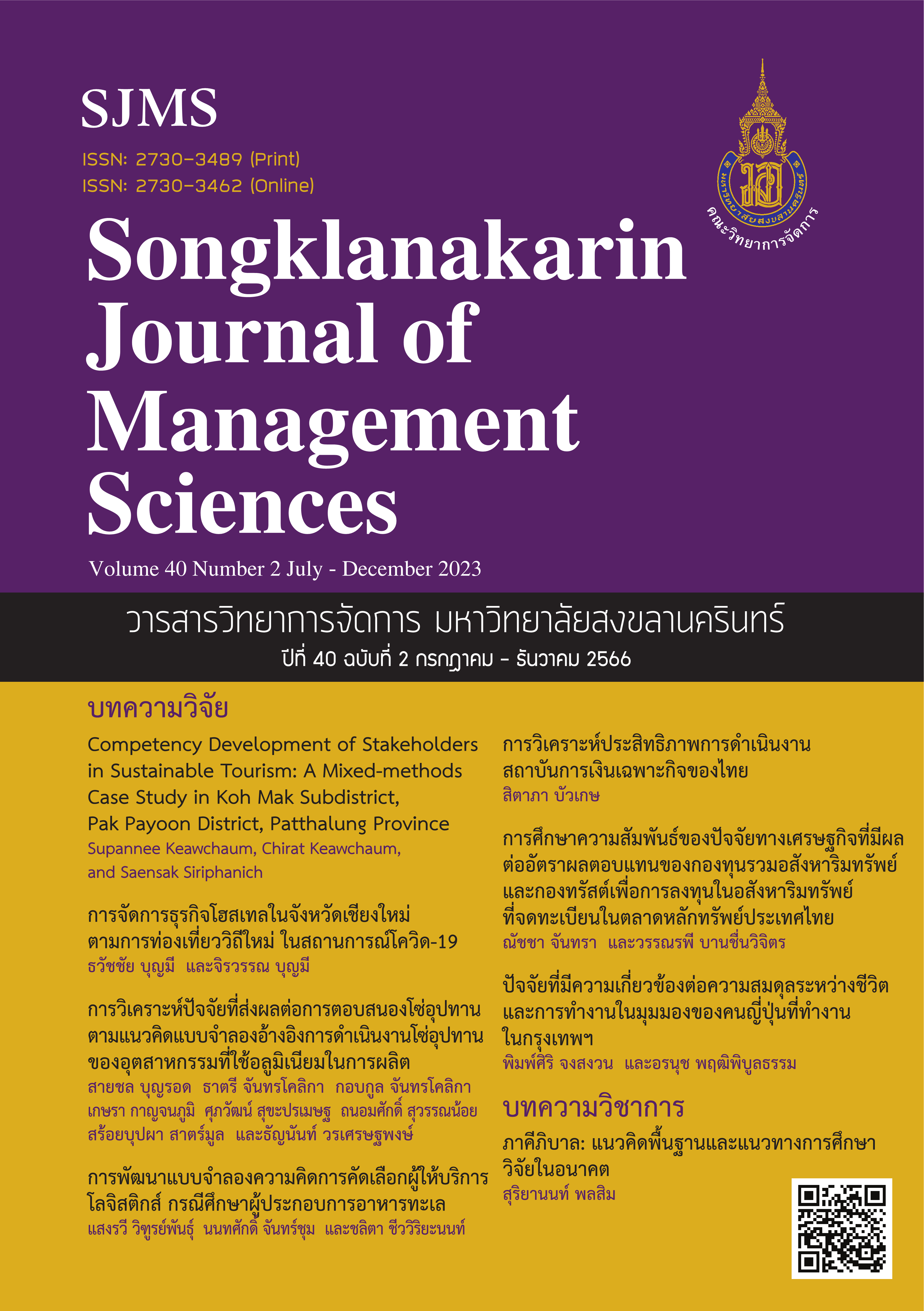An Analysis of Operational Efficiency of Thai Specialized Financial Institutions
Main Article Content
Abstract
Thai Specialized financial institutions are important since they are established with the aim of providing services to people who cannot access the services from commercial banks. Measuring the efficiency of specialized financial institutions presents the operational efficiency and opportunities to improve their operations. The purpose of this research is to study the operational efficiency of six specialized financial institutions which have the bank status and play an important role in providing financial services to the people. The Data Envelopment Analysis tool is employed to measure the efficiency and the intermediation approach is applied in selecting inputs and outputs. The inputs are deposits, debt securities and borrowings, employee expenses and fixed assets. The outputs are loans and investments. The data are collected from the financial statements of each specialized financial institution. The results of this study present that specialized financial institutions have a high level of efficiency with an average efficiency of 0.985. The Export-Import Bank of Thailand, Government Housing Bank and Government Saving Bank have technical and scale efficiency. Bank for Agriculture and Agricultural Cooperative, Islamic Bank of Thailand and Small and Medium Enterprise Development Bank of Thailand have been able to improve their operations to have technical efficiency since 2017. Considering the scale efficiency, the Bank for Agriculture and Agricultural Cooperatives is a specialized financial institution that has scale inefficiency with too large production. Therefore, it should improve the operations by separating its departments to reduce the production scale to the optimal.
Article Details

This work is licensed under a Creative Commons Attribution-NonCommercial-NoDerivatives 4.0 International License.
All published articles are SJMS’s copyright. The editorial board allows all published articles to be copied, excerpted, or disseminated with academic citation.
References
Ahn, H., & Le, M. H. (2014). An Insight into the Specification of the Input-Output Set for DEA-Based Bank Efficiency Measurement. Management Review Quarterly, 64(1), 3-37.
Areethai, A. (2008). Comparative Performance of Thai Commercial Banks: Data Envelopment Analysis (Master’s Independent Study). Thammasat University, Bangkok.
Bank of Thailand. (2019a). Supervision of Specialized Financial Institutions. Retrieved May 5, 2019, from https://www.bot.or.th/Thai/FinancialInstitutions/PruReg_HB/Pages/SFIs.aspx
__________. (2019b). Thailand’s Financial Institutions. Retrieved May 5, 2019, from https://www.bot.or.th/English/FinancialInstitutions/FIStructure/Pages/default.aspx
Banker, R. D., Charnes, A., & Cooper, W. W. (1984). Some Models for Estimating Technical and Scale Inefficiencies in Data Envelopment Analysis. Management Science, 30(9), 1078-1092.
Charnes, A., Cooper, W. W., & Rhodes, E. (1978). Measuring the Efficiency of Decision Making Units. European Journal of Operational Research, 2(6), 429-444.
Charoen-Aparutsamee, N. (2020). A Study of Advantages and Disadvantages from Tax Burdens between Commercial Banks and Specialized Financial Institutions. FPO Journal, 32(103), 30-34.
Chitkratok, P. (2015). Determinants of Thai Commercial Banks Efficiency During 2008-2014 (Master’s Case Study Research). Thammasat University, Bangkok.
Fethi, D. M., & Passiouras, F. (2009). Assessing Bank Performance with Operational Research and Artificial Intelligence Techniques: A Survey. University of Bath School of Management Working Paper Series, 1-66.
Harnhirun, S. (2006). The Concept of Measuring Productivity in Economics. Retrieved July 15, 2019, from https://www.oie.go.th/article/effi.pdf
Hemman, W. (2010). Operational Efficiency of Thai Non-Life Insurance Business (Master’s Thesis). National Institute of Development Administration, Bangkok.
Jenkins, L., & Anderson, M. (2003). A Multivariate Statistical Approach to Reducing the Number of Variables in Data Envelopment Analysis. European Journal of Operational Research, 147(1), 51-61.
Kosta, K. (2011). Efficiency Assessment of Commercial Banks in Asia Using Data Envelopment Analysis (DEA) (Master’s Independent Study). Thammasat University, Bangkok.
Luo, Y., Bi, G., & Liang, L. (2012). Input/Output Indicator Selection for DEA Efficiency Evaluation: An Empirical Study of Chinese Commercial Banks. Expert Systems with Applications, 39(1), 1118-1123.
Madhanagopal, R., & Chandrasekaran, R. (2014). Selecting Appropriate Variables for DEA Using Genetic Algorithm (GA) Search Procedure. International Journal of Data Envelopment Analysis and Operation Research, 1(2), 28-33.
Ngo, D. T., & Nguyen, L. T. P. (2012). Total Factor Productivity of Thai Banks in 2007-2010. An Application of DEA and Malmquist Index. Journal of Applied Finance & Banking, 2(5), 27-42.
Pradit-Ukrit, S., Sinthavalai, R., & Meemongkol, N. (2013) Efficiency Assessment of Rubber Plantation Aid Cooperation Plants (RCOPs) in Songkhla Province Using Data Envelopment Analysis (DEA). KKU Research Journal, 18(5), 793-802.
Rueangrit, C. (2013). An Analysis of the Operational Efficiency of Specialized Financial Institutions (Master’s Thesis). Ramkhamhaeng University, Bangkok.
Sahunan, S., & Witthawassamrankul, K. (2018). Measuring Operational Efficiency of Specialized Financial Institutions in Thailand by Data Envelopment Analysis (DEA), Proceeding of the 12th National Conference of Economists (450-462). Bangkok: Ramkhamhaeng University.
Sealey, C. W., & Lindley, J. T. (1977). Inputs, Outputs, and Theory of Production Cost at Depository Financial Institutions. Journal of Finance, 32(4), 1251-1266.
Suebpongsakorn, A., Khaekhai, C., Prakeetawathin, T., Rungpromprathan, W., & Saeing, S. (2016). A Measurement of Operation Efficiency of the Commercial Banks in Thailand by the Data Envelopment Analysis Method. University of the Thai Chamber of Commerce Journal, 36(3), 59-78.
Sufian F., & Habibullah, M. S. (2010). Developments in the Efficiency of the Thailand Banking Sector: A DEA Approach. International Journal of Development, 9(3), 226-245.
Untong, A. (2005). Manual of Using Program DEAP 2.1 for Analyzing Efficiency of Data Envelopment Analysis. Retrieved July 15, 2019, from https://piboonrungroj.files.wordpress.com/2011/08/akarapong_handbook_dea.pdf
Vu, L. T., Nguyen, N. T., & Dinh, L. H. (2019). Measuring Banking Efficiency in Vietnam: Parametric and Non-parametric Methods. Banks and Bank Systems, 14(1), 55-64.

